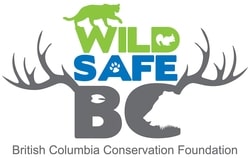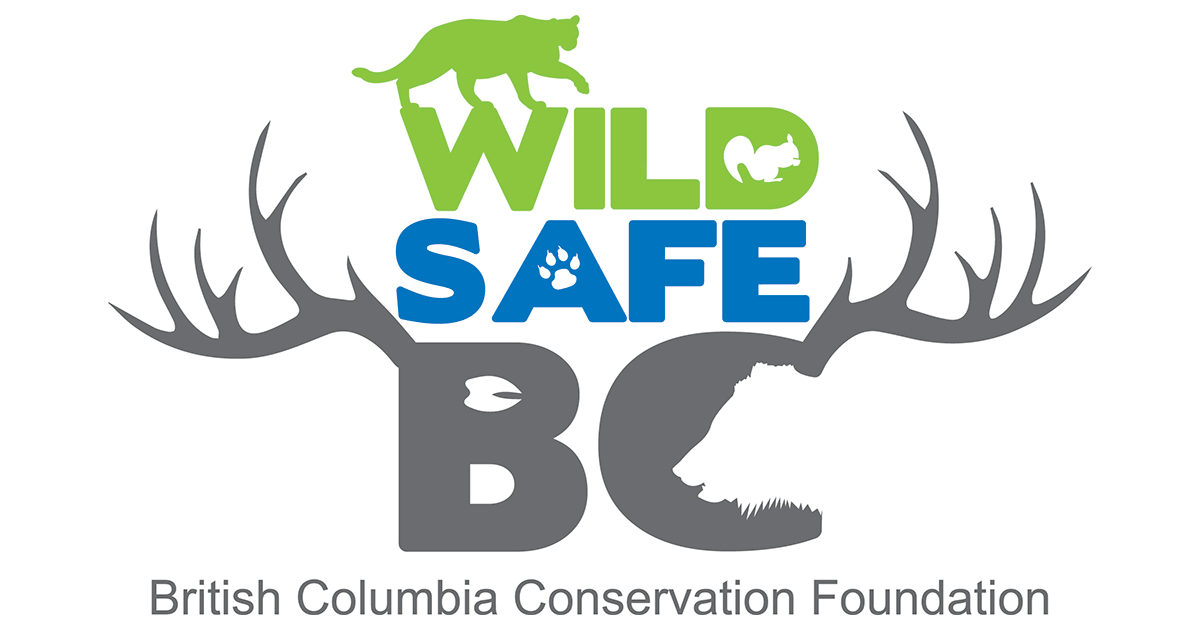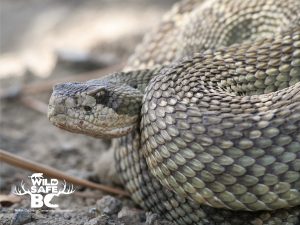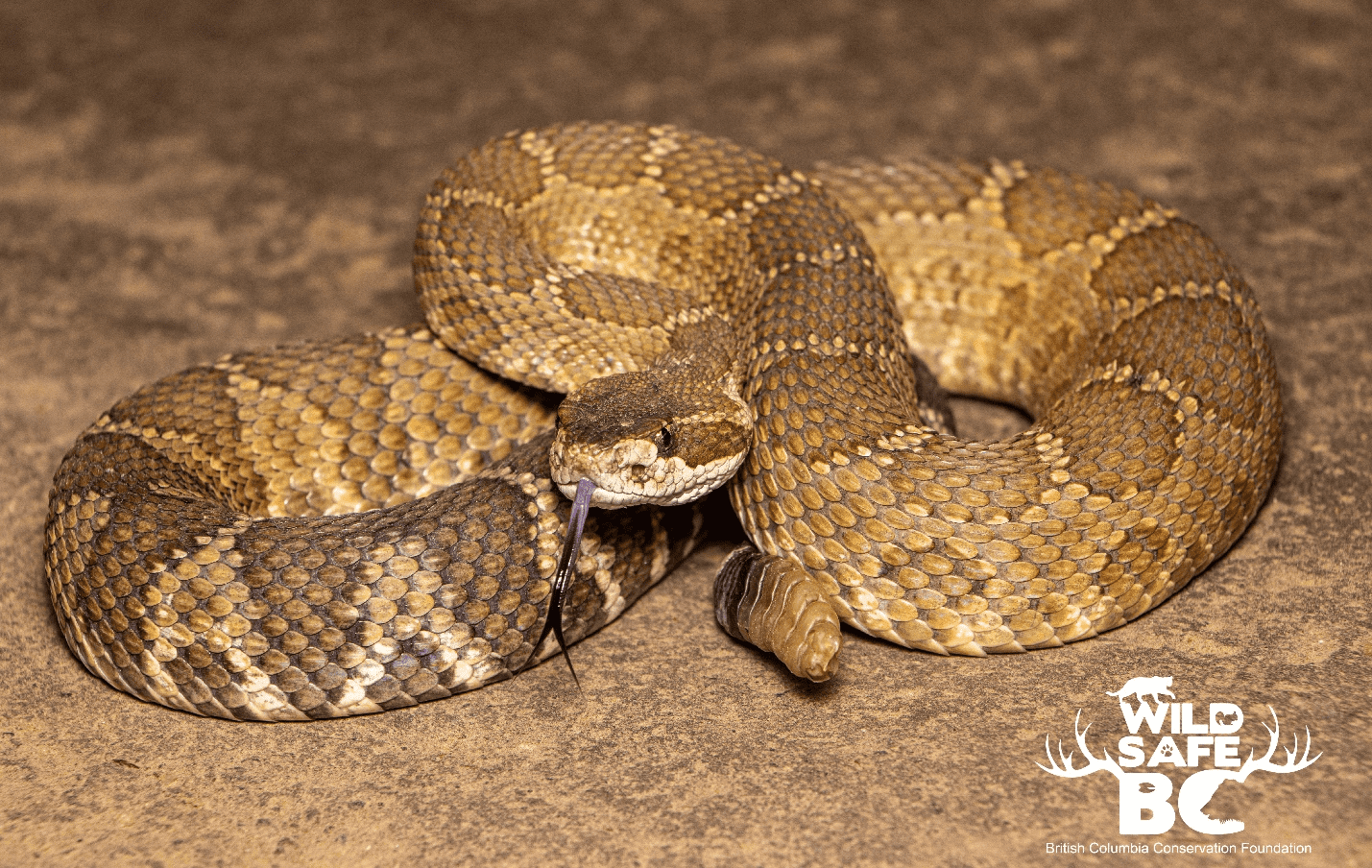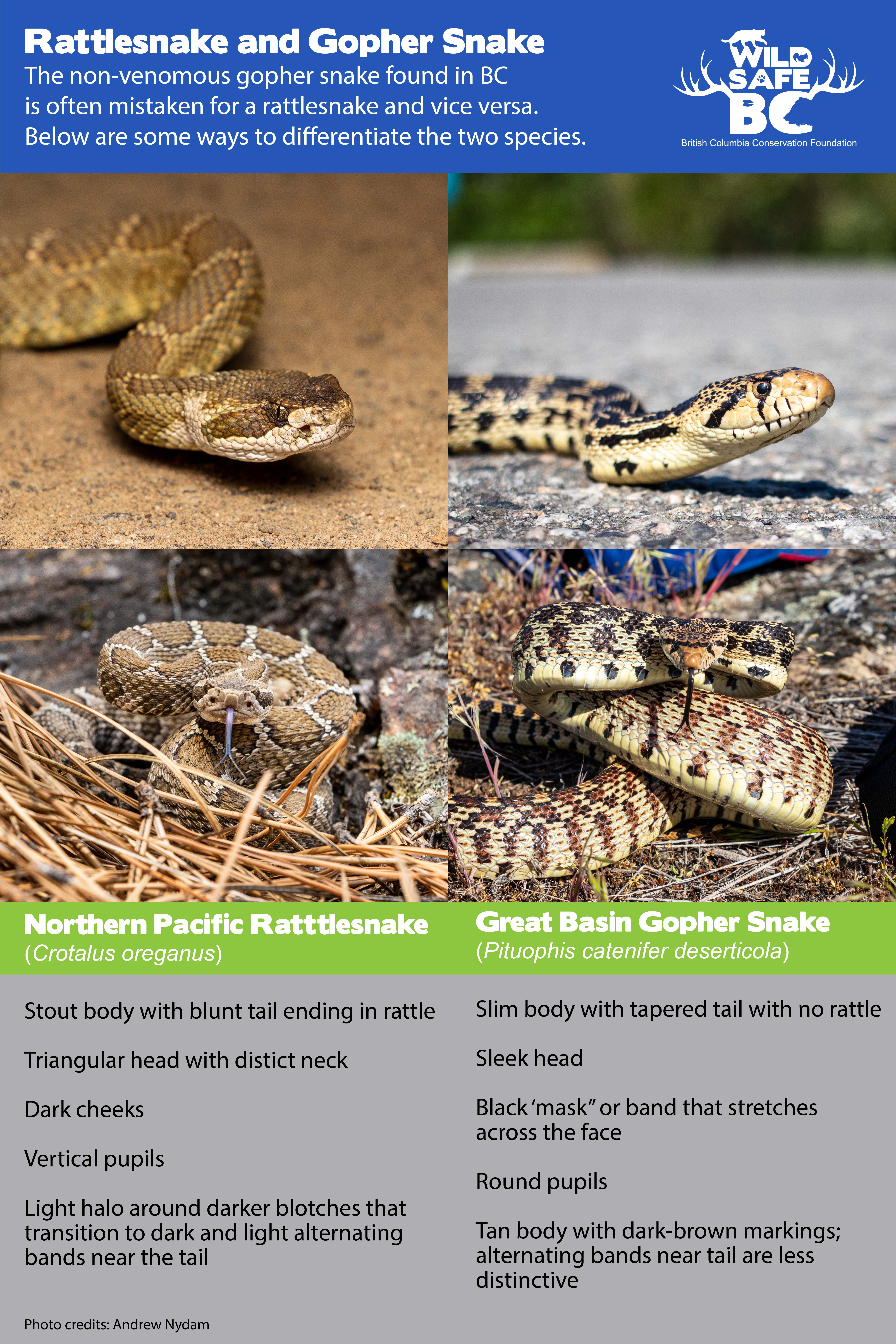Rattlesnake
Rattlesnake Snapshot
The Northern Pacific Rattlesnake (Crotalus oreganus oreganus) is the only rattlesnake found in BC and one of only three remaining rattlesnake species in Canada. They are generally found in the Southern Interior. Rattlesnakes are generally shy and non-aggressive. Rattlesnakes are protected by the BC Wildlife Act and receive additional protection under Federal legislation as a species at risk. As a result of increased human encroachment, persecution and the dangers of roads, they are also a ‘blue listed’ species provincially. It is illegal to harm, capture or kill a rattlesnake.
Rattlesnakes are the only snake in BC that has a rattle. The Great Basin gopher snake may try to mimic a rattle by shaking tail in dry leaves or vegetation, hiss or strike out. Rattlesnakes can grow to just over one meter in length and can weigh up to about 900 grams. They range in colour from olive-green to tan, with dark blotches along their backs.
Normally less than five people a year are bitten by rattlesnakes in BC. Bites are rarely fatal if treated promptly. Most snake bites are due to people deliberately trying to handle or harm rattlesnakes. Off-leash dogs that venture off trails are at higher risk than leashed dogs to receive a snake bite.
The Conservation Officer Service receives approximately 40 calls per year regarding rattlesnakes. Rattlesnakes should ONLY be moved if they are a direct threat to you or your family. Phone the Conservation Officer Reporting Line at 1-877-952-7277 or your local Bylaw or Animal Control Office to arrange for someone to move the snake.
Wild Rattlesnake Facts
Rattlesnake Facts
- The length of a rattlesnake’s rattle does NOT tell you how old the snake is. Rattlesnakes gain a new rattle segment each time they shed, which may occur more than once in a season, depending on how fast they grow.
- Baby rattlesnakes do not have a rattle. They are born with what is called a hard “button”. They begin to form their rattle as they grow and shed, forming a new rattle segment each time.
- Rattlesnakes have heat-sensing pits under their nostrils, which they use like binocular vision to locate warm-blooded prey.
- Rattlesnakes are ovoviviparous, meaning they hold their eggs internally and then give birth to live young.
- Rattlesnakes mate in late summer, but females do not give birth until the following fall. Females do not usually travel or hunt during this time, which means they can go over a year without eating!
- Rattlesnakes in British Columbia can move relatively great distances over a summer. They have been documented up to four kilometers away from their den sites!
- Rattlesnake dens are called hibernaculums
- Rattlesnakes are constantly growing a new set of fangs
- Biting is a reflex action that can occur even after a snake is dead. Do not touch a rattlesnake, dead or alive
Identification
The Northern Pacific Rattlesnake (Crotalus oreganus oreganus) is the only rattlesnake found in British Columbia and one of only three remaining rattlesnake species in all of Canada. Rattlesnakes can grow to just over one meter in length and can weigh up to about 900 grams. They range in colour from olive-green to tan, with dark blotches along their backs. The blotches turn into alternating dark and light bands near their tail, which ends in a rattle in adults.
Other snakes such as the non-venomous Great Basin gopher snake (Pituophis catenifer deserticola) and Western terrestrial garter snake (Thamnopshis elegans vagrans) are often mistaken for a rattlesnake, and vice versa. While there are fundamental physical differences between the two snake species, they may look similar from a distance or when moving through vegetation. However, only the adult rattlesnake has a rattle. Below are some ways to differentiate the two snakes. Note that many juvenile snakes in BC also have blotches similar to a rattlesnake until they mature (e.g. yellow-bellied racer, Great Basin gopher snake, Western terrestrial garter snake). Visit www.bcreptiles.ca/snakes to learn more about different snakes in BC.
Although the two snakes have similar colouration, gopher snakes tend to be tan in colour (a cream-yellow to grey-yellow) with dark brown-black blotches. Rattlesnakes range in colour from olive-green to tan, with dark blotches along their backs. The blotches on a rattlesnake turn into alternating dark and light (often white) bands near their tail, which ends in a rattle. The blotches on a gopher snake appear to turn into bands towards the tail, but are not necessarily as distinctive as on a rattlesnake. In addition to square-like blotches along the spine, gopher snakes may have blotches along their sides as well.
Gopher snakes have a black ‘mask’ on their face; the black band stretches across the eyes from each corner of the mouth.
Rattlesnakes have a triangular-shaped head, which is distinct from their neck and the rest of their body. Gopher snakes have a sleek head that is the same width as their neck and their body gradually widens towards the middle of their body.
A gopher snake will mimic a rattlesnake’s rattle when feeling threatened. By shaking and vibrating the end of its tail in leaves and dried vegetation, it may convince you it is a rattlesnake. A very scared and threatened gopher snake may also hiss and strike out.
Biology
Rattlesnakes spend all winter in communal dens called hibernaculums. They often share these dens with other snake species from approximately October to April. When they emerge in the spring, they travel from their dens to well-used foraging grounds where they feed primarily on small mammals, before returning to den sites in the fall. Pregnant females, however, remain close to their den site in areas known as ‘gestation sites’ or ‘rookeries’ for the entire summer. There they will regulate their body temperature carefully and gestate their young. They mate in late summer, and do not give birth to their live young until the following fall. This means they may go over a year without eating! Due to how energetically costly this process is, females only mate every two to three years.
These animals are extremely sensitive to human encroachment, and unfortunately experience the added pressure of road kill and direct persecution by humans. Rattlesnakes in BC are considered ‘threatened’ under federal legislation and are ‘Blue listed’ provincially. It is illegal to harm, kill, or capture a rattlesnake in BC.
Rattlesnakes are passive predators, often waiting for prey to find them. They locate prey by sensing the prey's body heat through their facial heat pits. Once prey is located, a rattlesnake strikes quickly and injects the prey with venom through its long, hollow fangs. Their prey includes shrews, deer mice, voles, pocket gophers, wood rats, marmots, squirrels, the occasional bird, and rarely, other snakes.
Behaviour
The rattlesnake is a member of the pit viper family and although it is venomous, it is generally shy and non-aggressive. If cornered, however, rattlesnakes will rattle their tails vigorously while forming an aggressive coil with the head raised and the neck. Striking is a last resort, usually employed if cornered by a predator or occasionally when suddenly stepped on.
Range and Habitat
Rattlesnakes in BC are found in the province’s dry south-central interior valleys. They live in a variety of habitats, from open forests to riparian areas. Often you will find them among sage brush and antelope brush in shrub-steppe habitat. They overwinter in communal dens (called hibernacula), often with other snake species. These can be usually be found in south-west facing talus slopes and rock slides.
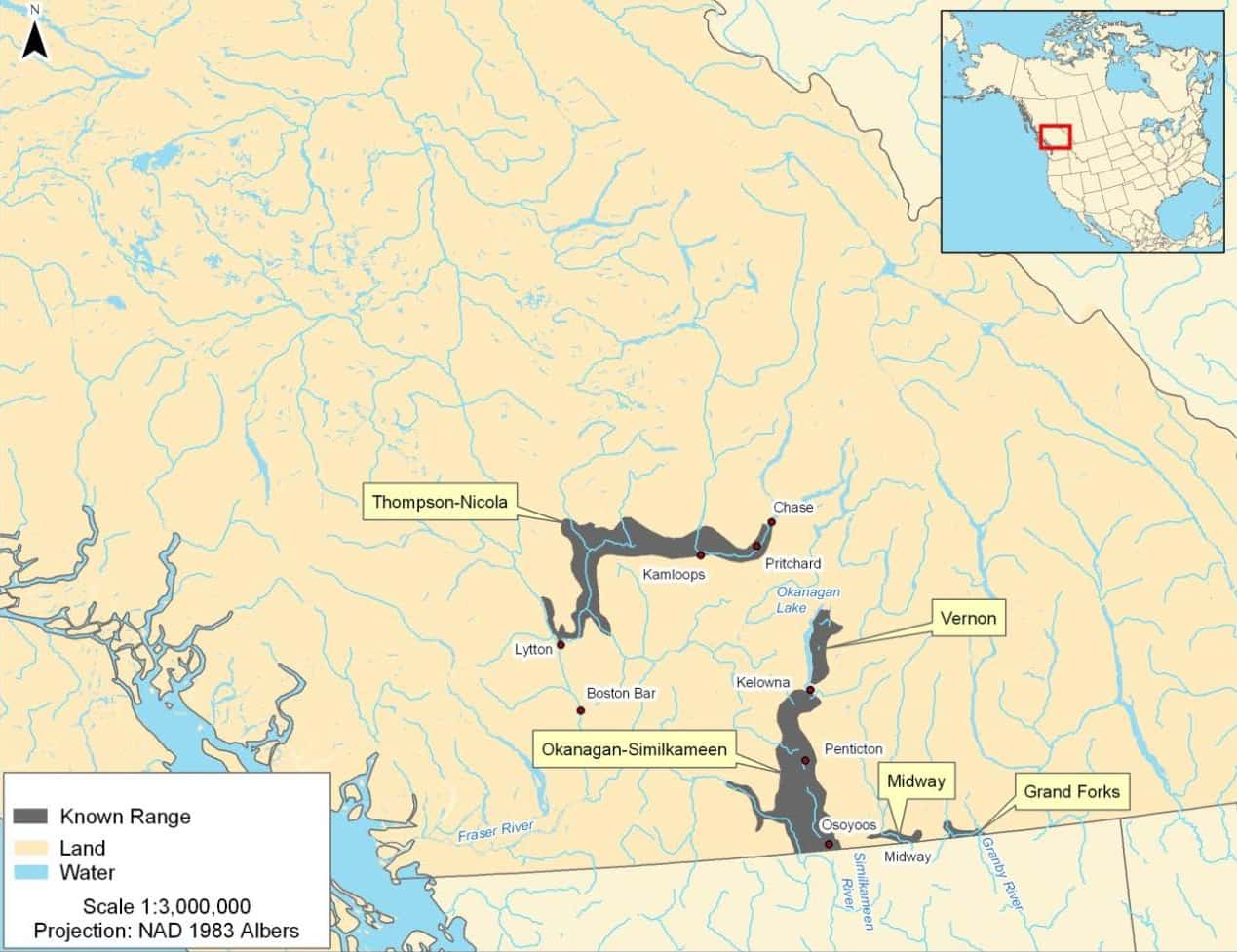
Map Source:
COSEWIC. 2015. COSEWIC assessment and status report on the Western Rattlesnake Crotalus oreganus in Canada. Committee on the Status of Endangered Wildlife in Canada. Ottawa.
Reporting Rattlesnakes
If you encounter a rattlesnake and you would like to add this information to the Province’s database for conservation research, please use the form located here:
https://www2.gov.bc.ca/gov/content/environment/plants-animals-ecosystems/wildlife/wildlife-data-information/submit-wildlife-data-information
Rattlesnake Safety
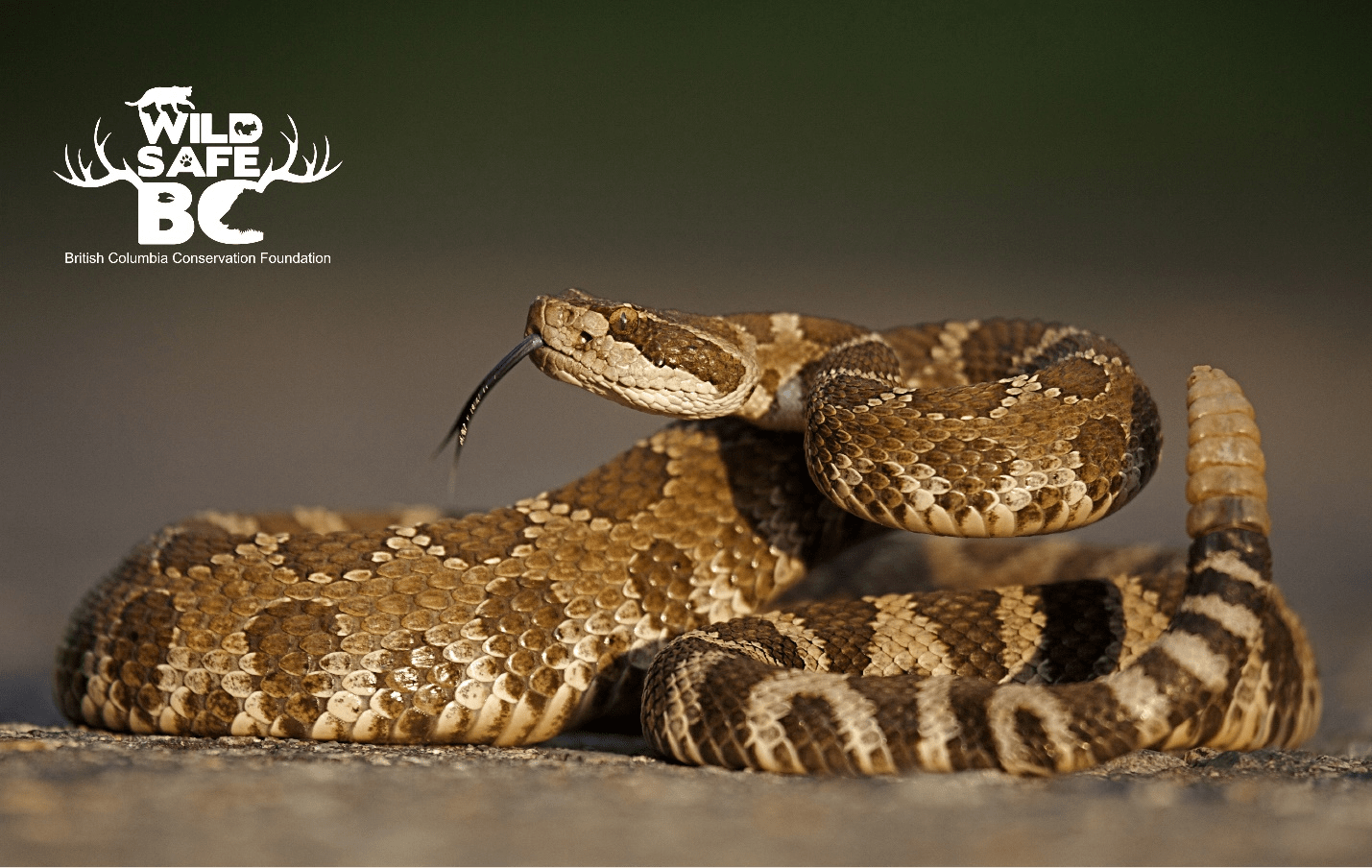
Rattlesnake bites are very rare in British Columbia and are almost never fatal. Most snake bites are due to people deliberately trying to handle or harm rattlesnakes. The most important thing to remember is to get the victim to the hospital. If you are bitten:
1. Stay calm and remove yourself from the area. Move slowly or be carried.
2. Remove any constrictive clothing or jewelry, which otherwise would act as a tourniquet and concentrate the venom and prevent fresh blood from entering the area (which is not desirable).
3. Go to the nearest hospital. Phone ahead if possible, or phone 911. Preferably, have someone else drive you.
4. Mark swelling with lines and times every 10 minutes or so. This will help doctors assess the severity of the bite.
5. If necessary, you may clean the bite area to prevent further infection.
6. Do not: apply a tourniquet, make an incision, attempt to suck out the venom, ice the wound, kill the snake, or bring the snake to the hospital. Snakes are protected by law and doctors do not need to identify a snake to treat a snake bite in BC.
How to Avoid Being Bitten by Rattlesnake
- Familiarize yourself with rattlesnake habitat and behaviour.
- Wear long loose pants and use high leather or rubber boots while working in tall grass or shrubs.
- Don’t put your hands and feet where you cannot see them.
- Use a stick to turn over an object under which you think a snake could be hidden.
- Walk around rocks and logs; do not step over as a snake may be resting on the other side.
If you hear a rattlesnake:
- Stop immediately and locate the snake.
- If you are close to the snake, remain still and allow the snake to calm down and back away.
- Once you are one snake body length away, step back and go around the snake.
If you encounter a dead rattlesnake, don’t touch it! The biting reflex remains even after death.
Do not expect all rattlesnakes to rattle at you. Their first response to disturbance is to stay camouflaged and hide. Their second response is to escape. They usually will only rattle when cornered, surprised, or when they feel very threatened. Striking is usually a last resort. Warning signs of a strike include a body in a coil, head slightly raised with the neck in an ‘s’ shaped curve, and rattling.
Children and Rattlesnakes
Teach your children what a rattlesnake looks like and what the appropriate response is if they encounter one while enjoying the outdoors or playing in your backyard. If your child is bitten by a rattlesnake, get them to the hospital immediately. Although rattlesnake bites are rarely fatal, children and individuals with compromised immune systems are most at risk for complications.
Dogs and Rattlesnakes in BC*
Dogs off-leash are at risk of disturbing a rattlesnake and being bitten. However, dog fatalities are rare as long as they are treated by veterinarian. The most common symptoms are pain, swelling and necrosis of the tissues. The best way to prevent snake bites is to avoid areas with rattlesnakes or keep your pets leashed and stick to well-marked trails when rattlesnakes are active (April to October). If you have a yard that backs onto rattlesnake habitat, make sure to have it properly fenced (see Snake Fencing section in the "Conflict Reduction" tab).
If your dog is bitten:
- Stay calm and retrieve your pet without getting bitten yourself
- Do not kill the snake or bring it with you
- Try to calm your pet and pick it up if possible
- Bring your pet to the closest emergency vet clinic
- Do not apply a tourniquet, make an incision, or try to suck out the venom
*Please note that this advice pertains to rattlesnakes in British Columbia only. Some rattlesnakes in other parts of North America may be more venomous. Seek local advice when travelling.
Conflict Reduction with Rattlesnakes
Attractants
You might not realize it, but there are many things around your home that may be attracting snakes. There are several things you can do to help keep your home and garden rattlesnake-free.
- Fill holes around your house and outbuildings with boards, steel wool or caulking. If you think a mouse can fit, it’s likely a snake can too.
- Remove piles of rocks, wood, or other materials provide convenient basking and retreat sites for snakes. Keep your yard free of cover objects.
- Close in decks and stairs. Use skirting so that snakes cannot access storage areas under decks and stairs where they feel safe.
- Keep your yard rodent-free. Spillage from bird feeders, pet food, and poorly managed garbage and compost can attract rodents, which are the primary prey of rattlesnakes.
- Remember that water features can attract snakes. Raised bird baths are preferred to ground level features.
- Consider installing snake barrier fencing around your home or parts of your yard (see below).
Snake Fencing
Fencing is an effective way to prevent snakes from entering your yard, but it must be constructed properly and maintained regularly. Below are some guidelines for building a snake fence.
- Use ¼”wire mesh fencing material.
- Bury the fencing at least 6” (10 -12” is recommended) underground. This prevents snakes from using holes made by rodents burrowing under the fence, and allows for substrate erosion from rain and wind.
- The mesh wire must extend at least 2 feet above ground.
- You may attach the wire mesh material to existing fences, but it is often more effective to construct a new or stand-alone fence.
- Clear any weeds or shrubs along the fence line on both sides to prevent pile-ups of vegetation that snakes may use to climb over the fence.
Depending on the soil type found where you are building your fence, you can use posts and top-rails, or chain link fencing (with mesh wire attached). Either way, you will still need to dig a trench for the bottom of the mesh.
If not already attached to an existing fence, the top of the mesh wire must be reinforced to prevent damage from passing animals or falling vegetation. Options include using rails, or additional strong smooth wire atop of the mesh fencing.
In certain cases, you may need to install a gate for access, while still ensuring the continuation of the snake barrier fencing. Options for gates include framing mesh within a strong metal frame that slides into a channel or groove cut into a bottom rail (concrete or wooden post, partially buried underground). Modified cattle guards with snake exit ramps may be used for areas with high vehicle traffic.
As snakes do occasionally find their way across fence lines (especially if you or your neighbours do not maintain your fences), you may install escape funnels. Funnels are made from the same material as the snake fence, and are small cone-shaped funnels, attached outwardly from the fence. The design of the funnel is such that snakes may exit from the interior of the fenced area, but are unlikely to enter (the funnel is installed so that the smaller opening is elevated from the ground, allowing snakes on the other side of the fence to pass along underneath). You may also attach a small, short section of fencing perpendicular to the inside of the fence line, in order to divert snakes into the funnel.
Inspect and repair any damage to your fencing each spring, before snakes make their movements from their dens. Monitor the fencing monthly for any wear and tear, erosion, holes, and/or vegetation pile-up.
Relocating a Rattlesnake
If you encounter a rattlesnake that needs to be moved, please report it to the Conservation Officer Service at 1-877-952-7277 or your local Animal Control Office. Most commonly, rattlesnakes need to be relocated by a trained person either because they are on a person’s property and a direct threat to your family or pets, or because they are in a location where they are likely to be injured or killed. Remember, rattlesnakes are protected and it is illegal to harm, kill, or capture a rattlesnake in BC.
If you MUST move a rattlesnake out of your yard yourself (e.g. to the correct side of a snake fence), follow these steps and safety precautions:
- Maintain a buffer zone for people and pets.
- Wear appropriate clothing and footwear (long loose trousers and high-sided leather or rubber boots).
- Reduce the chance of the snake becoming alarmed, defensive, or aggressive (it will be much more difficult to capture).
- If you must leave to collect equipment, designate someone to keep an eye on the snake (and any members of the public) from a safe distance.
- A simple stick or broom can be used to move the snake.
- Sweep or prod the snake gently into a large open bin (such as an overturned garbage bin). Keep your hands OUT of the way of the opening and away from the snake.
- Replace the lid of the container, while keeping hands out of the way.
Release the snake in an appropriate area immediately (into a covered area, with vegetation and shade). Never leave the snake unattended. Keep it in view and in the shade. Snakes cannot regulate their own body temperature and overheat in direct sunlight very quickly. When releasing, carefully remove the lid, with hands and arms out of the way, place bin on its side and slowly tip snake out, or use long stick or broom handle to gently move the snake out.
Rattlesnake Resources
- BC Ecosystem Explorer
- Reptiles of BC
- Provincial Wildlife Data Form: For submitting rattlesnake sighting data.
Rattlesnake Snapshot
The Northern Pacific Rattlesnake (Crotalus oreganus oreganus) is the only rattlesnake found in BC and one of only three remaining rattlesnake species in Canada. They are generally found in the Southern Interior. Rattlesnakes are generally shy and non-aggressive. Rattlesnakes are protected by the BC Wildlife Act and receive additional protection under Federal legislation as a species at risk. As a result of increased human encroachment, persecution and the dangers of roads, they are also a ‘blue listed’ species provincially. It is illegal to harm, capture or kill a rattlesnake.
Rattlesnakes are the only snake in BC that has a rattle. The Great Basin gopher snake may try to mimic a rattle by shaking tail in dry leaves or vegetation, hiss or strike out. Rattlesnakes can grow to just over one meter in length and can weigh up to about 900 grams. They range in colour from olive-green to tan, with dark blotches along their backs.
Normally less than five people a year are bitten by rattlesnakes in BC. Bites are rarely fatal if treated promptly. Most snake bites are due to people deliberately trying to handle or harm rattlesnakes. Off-leash dogs that venture off trails are at higher risk than leashed dogs to receive a snake bite.
The Conservation Officer Service receives approximately 40 calls per year regarding rattlesnakes. Rattlesnakes should ONLY be moved if they are a direct threat to you or your family. Phone the Conservation Officer Reporting Line at 1-877-952-7277 or your local Bylaw or Animal Control Office to arrange for someone to move the snake.
Wild Rattlesnake Facts
Rattlesnake Facts
- The length of a rattlesnake’s rattle does NOT tell you how old the snake is. Rattlesnakes gain a new rattle segment each time they shed, which may occur more than once in a season, depending on how fast they grow.
- Baby rattlesnakes do not have a rattle. They are born with what is called a hard “button”. They begin to form their rattle as they grow and shed, forming a new rattle segment each time.
- Rattlesnakes have heat-sensing pits under their nostrils, which they use like binocular vision to locate warm-blooded prey.
- Rattlesnakes are ovoviviparous, meaning they hold their eggs internally and then give birth to live young.
- Rattlesnakes mate in late summer, but females do not give birth until the following fall. Females do not usually travel or hunt during this time, which means they can go over a year without eating!
- Rattlesnakes in British Columbia can move relatively great distances over a summer. They have been documented up to four kilometers away from their den sites!
- Rattlesnake dens are called hibernaculums
- Rattlesnakes are constantly growing a new set of fangs
- Biting is a reflex action that can occur even after a snake is dead. Do not touch a rattlesnake, dead or alive
Identification
The Northern Pacific Rattlesnake (Crotalus oreganus oreganus) is the only rattlesnake found in British Columbia and one of only three remaining rattlesnake species in all of Canada. Rattlesnakes can grow to just over one meter in length and can weigh up to about 900 grams. They range in colour from olive-green to tan, with dark blotches along their backs. The blotches turn into alternating dark and light bands near their tail, which ends in a rattle in adults.
Other snakes such as the non-venomous Great Basin gopher snake (Pituophis catenifer deserticola) and Western terrestrial garter snake (Thamnopshis elegans vagrans) are often mistaken for a rattlesnake, and vice versa. While there are fundamental physical differences between the two snake species, they may look similar from a distance or when moving through vegetation. However, only the adult rattlesnake has a rattle. Below are some ways to differentiate the two snakes. Note that many juvenile snakes in BC also have blotches similar to a rattlesnake until they mature (e.g. yellow-bellied racer, Great Basin gopher snake, Western terrestrial garter snake). Visit www.bcreptiles.ca/snakes to learn more about different snakes in BC.
Although the two snakes have similar colouration, gopher snakes tend to be tan in colour (a cream-yellow to grey-yellow) with dark brown-black blotches. Rattlesnakes range in colour from olive-green to tan, with dark blotches along their backs. The blotches on a rattlesnake turn into alternating dark and light (often white) bands near their tail, which ends in a rattle. The blotches on a gopher snake appear to turn into bands towards the tail, but are not necessarily as distinctive as on a rattlesnake. In addition to square-like blotches along the spine, gopher snakes may have blotches along their sides as well.
Gopher snakes have a black ‘mask’ on their face; the black band stretches across the eyes from each corner of the mouth.
Rattlesnakes have a triangular-shaped head, which is distinct from their neck and the rest of their body. Gopher snakes have a sleek head that is the same width as their neck and their body gradually widens towards the middle of their body.
A gopher snake will mimic a rattlesnake’s rattle when feeling threatened. By shaking and vibrating the end of its tail in leaves and dried vegetation, it may convince you it is a rattlesnake. A very scared and threatened gopher snake may also hiss and strike out.
Biology
Rattlesnakes spend all winter in communal dens called hibernaculums. They often share these dens with other snake species from approximately October to April. When they emerge in the spring, they travel from their dens to well-used foraging grounds where they feed primarily on small mammals, before returning to den sites in the fall. Pregnant females, however, remain close to their den site in areas known as ‘gestation sites’ or ‘rookeries’ for the entire summer. There they will regulate their body temperature carefully and gestate their young. They mate in late summer, and do not give birth to their live young until the following fall. This means they may go over a year without eating! Due to how energetically costly this process is, females only mate every two to three years.
These animals are extremely sensitive to human encroachment, and unfortunately experience the added pressure of road kill and direct persecution by humans. Rattlesnakes in BC are considered ‘threatened’ under federal legislation and are ‘Blue listed’ provincially. It is illegal to harm, kill, or capture a rattlesnake in BC.
Rattlesnakes are passive predators, often waiting for prey to find them. They locate prey by sensing the prey's body heat through their facial heat pits. Once prey is located, a rattlesnake strikes quickly and injects the prey with venom through its long, hollow fangs. Their prey includes shrews, deer mice, voles, pocket gophers, wood rats, marmots, squirrels, the occasional bird, and rarely, other snakes.
Behaviour
The rattlesnake is a member of the pit viper family and although it is venomous, it is generally shy and non-aggressive. If cornered, however, rattlesnakes will rattle their tails vigorously while forming an aggressive coil with the head raised and the neck. Striking is a last resort, usually employed if cornered by a predator or occasionally when suddenly stepped on.
Range and Habitat
Rattlesnakes in BC are found in the province’s dry south-central interior valleys. They live in a variety of habitats, from open forests to riparian areas. Often you will find them among sage brush and antelope brush in shrub-steppe habitat. They overwinter in communal dens (called hibernacula), often with other snake species. These can be usually be found in south-west facing talus slopes and rock slides.

Map Source:
COSEWIC. 2015. COSEWIC assessment and status report on the Western Rattlesnake Crotalus oreganus in Canada. Committee on the Status of Endangered Wildlife in Canada. Ottawa.
Reporting Rattlesnakes
If you encounter a rattlesnake and you would like to add this information to the Province’s database for conservation research, please use the form located here:
https://www2.gov.bc.ca/gov/content/environment/plants-animals-ecosystems/wildlife/wildlife-data-information/submit-wildlife-data-information
Rattlesnake Safety

Rattlesnake bites are very rare in British Columbia and are almost never fatal. Most snake bites are due to people deliberately trying to handle or harm rattlesnakes. The most important thing to remember is to get the victim to the hospital. If you are bitten:
1. Stay calm and remove yourself from the area. Move slowly or be carried.
2. Remove any constrictive clothing or jewelry, which otherwise would act as a tourniquet and concentrate the venom and prevent fresh blood from entering the area (which is not desirable).
3. Go to the nearest hospital. Phone ahead if possible, or phone 911. Preferably, have someone else drive you.
4. Mark swelling with lines and times every 10 minutes or so. This will help doctors assess the severity of the bite.
5. If necessary, you may clean the bite area to prevent further infection.
6. Do not: apply a tourniquet, make an incision, attempt to suck out the venom, ice the wound, kill the snake, or bring the snake to the hospital. Snakes are protected by law and doctors do not need to identify a snake to treat a snake bite in BC.
How to Avoid Being Bitten by Rattlesnake
- Familiarize yourself with rattlesnake habitat and behaviour.
- Wear long loose pants and use high leather or rubber boots while working in tall grass or shrubs.
- Don’t put your hands and feet where you cannot see them.
- Use a stick to turn over an object under which you think a snake could be hidden.
- Walk around rocks and logs; do not step over as a snake may be resting on the other side.
If you hear a rattlesnake:
- Stop immediately and locate the snake.
- If you are close to the snake, remain still and allow the snake to calm down and back away.
- Once you are one snake body length away, step back and go around the snake.
If you encounter a dead rattlesnake, don’t touch it! The biting reflex remains even after death.
Do not expect all rattlesnakes to rattle at you. Their first response to disturbance is to stay camouflaged and hide. Their second response is to escape. They usually will only rattle when cornered, surprised, or when they feel very threatened. Striking is usually a last resort. Warning signs of a strike include a body in a coil, head slightly raised with the neck in an ‘s’ shaped curve, and rattling.
Children and Rattlesnakes
Teach your children what a rattlesnake looks like and what the appropriate response is if they encounter one while enjoying the outdoors or playing in your backyard. If your child is bitten by a rattlesnake, get them to the hospital immediately. Although rattlesnake bites are rarely fatal, children and individuals with compromised immune systems are most at risk for complications.
Dogs and Rattlesnakes in BC*
Dogs off-leash are at risk of disturbing a rattlesnake and being bitten. However, dog fatalities are rare as long as they are treated by veterinarian. The most common symptoms are pain, swelling and necrosis of the tissues. The best way to prevent snake bites is to avoid areas with rattlesnakes or keep your pets leashed and stick to well-marked trails when rattlesnakes are active (April to October). If you have a yard that backs onto rattlesnake habitat, make sure to have it properly fenced (see Snake Fencing section in the "Conflict Reduction" tab).
If your dog is bitten:
- Stay calm and retrieve your pet without getting bitten yourself
- Do not kill the snake or bring it with you
- Try to calm your pet and pick it up if possible
- Bring your pet to the closest emergency vet clinic
- Do not apply a tourniquet, make an incision, or try to suck out the venom
*Please note that this advice pertains to rattlesnakes in British Columbia only. Some rattlesnakes in other parts of North America may be more venomous. Seek local advice when travelling.
Conflict Reduction with Rattlesnakes
Attractants
You might not realize it, but there are many things around your home that may be attracting snakes. There are several things you can do to help keep your home and garden rattlesnake-free.
- Fill holes around your house and outbuildings with boards, steel wool or caulking. If you think a mouse can fit, it’s likely a snake can too.
- Remove piles of rocks, wood, or other materials provide convenient basking and retreat sites for snakes. Keep your yard free of cover objects.
- Close in decks and stairs. Use skirting so that snakes cannot access storage areas under decks and stairs where they feel safe.
- Keep your yard rodent-free. Spillage from bird feeders, pet food, and poorly managed garbage and compost can attract rodents, which are the primary prey of rattlesnakes.
- Remember that water features can attract snakes. Raised bird baths are preferred to ground level features.
- Consider installing snake barrier fencing around your home or parts of your yard (see below).
Snake Fencing
Fencing is an effective way to prevent snakes from entering your yard, but it must be constructed properly and maintained regularly. Below are some guidelines for building a snake fence.
- Use ¼”wire mesh fencing material.
- Bury the fencing at least 6” (10 -12” is recommended) underground. This prevents snakes from using holes made by rodents burrowing under the fence, and allows for substrate erosion from rain and wind.
- The mesh wire must extend at least 2 feet above ground.
- You may attach the wire mesh material to existing fences, but it is often more effective to construct a new or stand-alone fence.
- Clear any weeds or shrubs along the fence line on both sides to prevent pile-ups of vegetation that snakes may use to climb over the fence.
Depending on the soil type found where you are building your fence, you can use posts and top-rails, or chain link fencing (with mesh wire attached). Either way, you will still need to dig a trench for the bottom of the mesh.
If not already attached to an existing fence, the top of the mesh wire must be reinforced to prevent damage from passing animals or falling vegetation. Options include using rails, or additional strong smooth wire atop of the mesh fencing.
In certain cases, you may need to install a gate for access, while still ensuring the continuation of the snake barrier fencing. Options for gates include framing mesh within a strong metal frame that slides into a channel or groove cut into a bottom rail (concrete or wooden post, partially buried underground). Modified cattle guards with snake exit ramps may be used for areas with high vehicle traffic.
As snakes do occasionally find their way across fence lines (especially if you or your neighbours do not maintain your fences), you may install escape funnels. Funnels are made from the same material as the snake fence, and are small cone-shaped funnels, attached outwardly from the fence. The design of the funnel is such that snakes may exit from the interior of the fenced area, but are unlikely to enter (the funnel is installed so that the smaller opening is elevated from the ground, allowing snakes on the other side of the fence to pass along underneath). You may also attach a small, short section of fencing perpendicular to the inside of the fence line, in order to divert snakes into the funnel.
Inspect and repair any damage to your fencing each spring, before snakes make their movements from their dens. Monitor the fencing monthly for any wear and tear, erosion, holes, and/or vegetation pile-up.
Relocating a Rattlesnake
If you encounter a rattlesnake that needs to be moved, please report it to the Conservation Officer Service at 1-877-952-7277 or your local Animal Control Office. Most commonly, rattlesnakes need to be relocated by a trained person either because they are on a person’s property and a direct threat to your family or pets, or because they are in a location where they are likely to be injured or killed. Remember, rattlesnakes are protected and it is illegal to harm, kill, or capture a rattlesnake in BC.
If you MUST move a rattlesnake out of your yard yourself (e.g. to the correct side of a snake fence), follow these steps and safety precautions:
- Maintain a buffer zone for people and pets.
- Wear appropriate clothing and footwear (long loose trousers and high-sided leather or rubber boots).
- Reduce the chance of the snake becoming alarmed, defensive, or aggressive (it will be much more difficult to capture).
- If you must leave to collect equipment, designate someone to keep an eye on the snake (and any members of the public) from a safe distance.
- A simple stick or broom can be used to move the snake.
- Sweep or prod the snake gently into a large open bin (such as an overturned garbage bin). Keep your hands OUT of the way of the opening and away from the snake.
- Replace the lid of the container, while keeping hands out of the way.
Release the snake in an appropriate area immediately (into a covered area, with vegetation and shade). Never leave the snake unattended. Keep it in view and in the shade. Snakes cannot regulate their own body temperature and overheat in direct sunlight very quickly. When releasing, carefully remove the lid, with hands and arms out of the way, place bin on its side and slowly tip snake out, or use long stick or broom handle to gently move the snake out.
Rattlesnake Resources
- BC Ecosystem Explorer
- Reptiles of BC
- Provincial Wildlife Data Form: For submitting rattlesnake sighting data.
